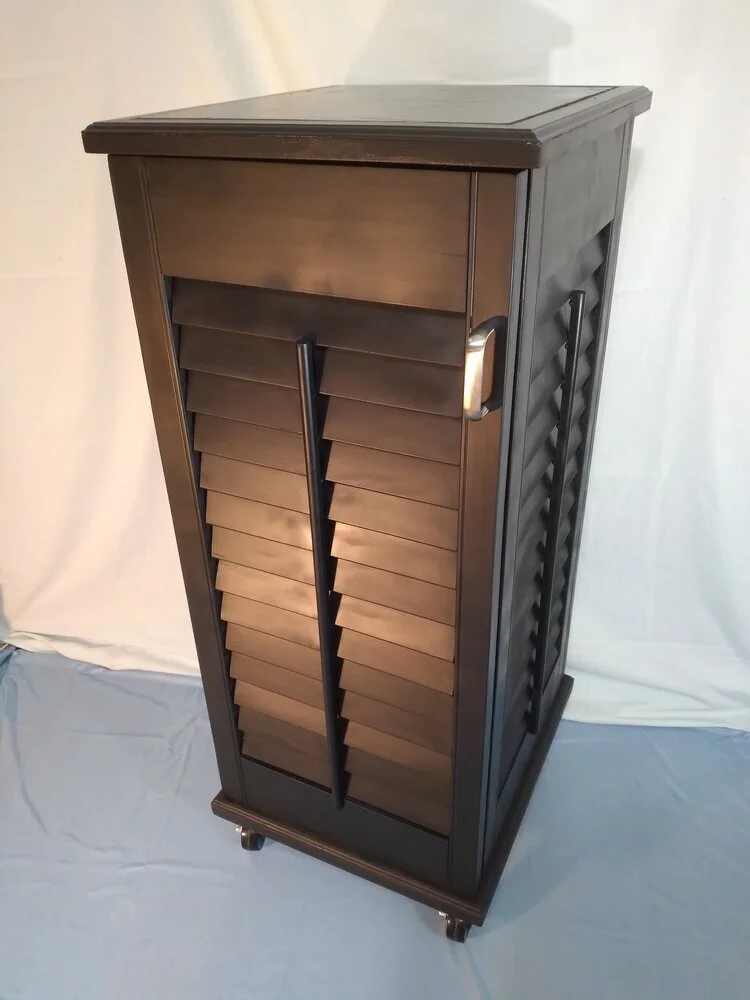Plantation Shutter Wine Bar
Dimensions: Height, 42.75 inches; Width, 17.75 inches; Depth, 20 inches; Weight, 75 pounds. This one-of-a-kind rolling wine bar can store 15 bottles of wine and up to 6 or 9 nine wine glasses, depending on their size. It’s a compact piece in terms of its footprint, and at pretty much standard bar height it’s comfortable for pouring glasses of wine for yourselves and your guests. Finished with black satin paint, it straddles the line between rustic and modern. Whether you keep any or all the shutters open or closed, it should draw a lot of positive attention. Can you imagine this piece in your living or dining room? Based on the cost of the new materials that went into this piece (see below), plus the labor hours and my sense of its potential market value, I’m asking $275 for it. Click here to purchase.
The Story
I was running one day in the Tenleytown neighborhood of D.C. when I spotted some shutters in someone’s driveway. After confirming that the homeowners were getting rid of them, I drove back and picked them up. They were in quite good shape, with only a few minor cracks/chips in some of the louvers. Pretty quickly, the idea of a wine bar came to mind, and I settled on that plan after confirming that wine bottles could easily fit inside once I formed the shutters into a rectangular box/cabinet. I removed the hardware and sanded down the minor flaws. I also used thin pieces of wood to fill in the mortised areas that held the eight original hinges, gluing and nailing these patches into place, and I used spackle to fill various holes. I lightly sanded all the surfaces to help new paint adhere. In the end, it took 9 or 10 cans of spray paint to adequately cover all four shutters—plus, I hand-painted the shelves and the top and bottom pieces. The shutters are held together, and the cabinet is attached to the top and bottom, with 2.5-inch-long wood screws. The hinges and handle on the door were purchased from my local Ace (Glover Park) Hardware store. Two magnetic latches help keep the door closed.
I made the shelves, bottom, and top from new lumber—laminated pine “project boards” from Lowes. (Wood has gotten much more expensive since the pandemic started.) The shelves are cut small enough to allow the shutters to fully open and are held in place with 2.5-inch corner brackets. (It would have been much easier to attach the shelves directly to the inside of the shutters, but then the shutters wouId not open. The things I do for the sake of design!) I used mostly new pieces of ¾-inch square dowel and 1x2 pine boards to define slots that would hold three bottles on each shelf, so they won’t roll around or clink into each other. The rails are glued and nailed into place. I stacked two big rectangles to make the bottom more substantial looking and used my router with an ogee bit to give it a fancier, slightly old-fashioned edge. Under the bottom I mounted four new casters from the Home Depot to make the wine bar mobile. For the top I created a frame with some new trim/moulding, also from The Home Depot, that has a similar ogee edge. I used my wet saw to cut a piece of leftover slate (free from a neighbor) to fit within the frame. I put two coats of Minwax water-based clear satin Polycrylic on it for protection and a slight sheen that would echo the black paint. I glued down the slate and then finished it with black sanded grout around the edges. Under the top I mounted a wine-glass rack. It’s brand new, but it’s one of two that someone in my neighborhood set out near the sidewalk with a “free” sign.
Related Items: Old Doors Wine Bar; Salvaged Shutter Shelves; Salvaged Shutter Cabinet with Doors; Salvaged Shutter Corner Shelves; Mirror, Shelf and Hooks on Reclaimed Shutters; Compact Metal Wine Bar Cart with Reclaimed Wood Shelves.


















